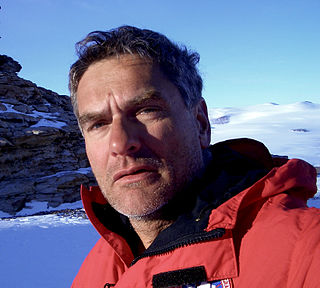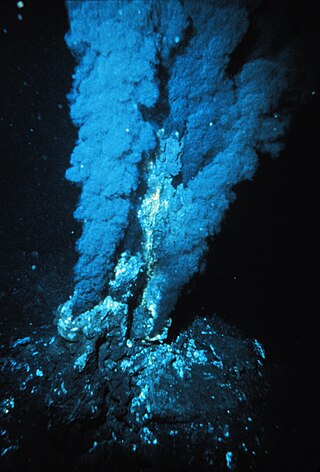Related Research Articles

Astrobiology is a scientific field within the life and environmental sciences that studies the origins, early evolution, distribution, and future of life in the universe by investigating its deterministic conditions and contingent events. As a discipline, astrobiology is founded on the premise that life may exist beyond Earth.

Europa, or Jupiter II, is the smallest of the four Galilean moons orbiting Jupiter, and the sixth-closest to the planet of all the 95 known moons of Jupiter. It is also the sixth-largest moon in the Solar System. Europa was discovered independently by Simon Marius and Galileo Galilei and was named after Europa, the Phoenician mother of King Minos of Crete and lover of Zeus.
The possibility of life on Mars is a subject of interest in astrobiology due to the planet's proximity and similarities to Earth. To date, no conclusive evidence of past or present life has been found on Mars. Cumulative evidence suggests that during the ancient Noachian time period, the surface environment of Mars had liquid water and may have been habitable for microorganisms, but habitable conditions do not necessarily indicate life.
A biosignature is any substance – such as an element, isotope, molecule, or phenomenon – that provides scientific evidence of past or present life on a planet. Measurable attributes of life include its physical or chemical structures, its use of free energy, and the production of biomass and wastes.
The NASA Astrobiology Institute (NAI) was established in 1998 by the National Aeronautics and Space Administration (NASA) "to develop the field of astrobiology and provide a scientific framework for flight missions." In December 2019 the institute's activities were suspended.

Christopher P. McKay is an American planetary scientist at NASA Ames Research Center, studying planetary atmospheres, astrobiology, and terraforming. McKay majored in physics at Florida Atlantic University, where he also studied mechanical engineering, graduating in 1975, and received his PhD in astrogeophysics from the University of Colorado in 1982.

Blood Falls is an outflow of an iron(III) oxide–tainted plume of saltwater, flowing from the tongue of Taylor Glacier onto the ice-covered surface of West Lake Bonney in the Taylor Valley of the McMurdo Dry Valleys in Victoria Land, East Antarctica.

Astrobiology Science and Technology for Exploring Planets (ASTEP) was a program established by NASA to sponsor research projects that advance the technology and techniques used in planetary exploration. The objective was to enable the study of astrobiology and to aid the planning of extraterrestrial exploration missions while prioritizing science, technology, and field campaigns.
Interplanetary contamination refers to biological contamination of a planetary body by a space probe or spacecraft, either deliberate or unintentional.
Richard Brice Hoover is a physicist who has authored 33 volumes and 250 papers on astrobiology, extremophiles, diatoms, solar physics, X-ray/EUV optics and meteorites. He holds 11 U.S. patents and was 1992 NASA Inventor of the Year. He was employed at the United States' NASA Marshall Space Flight Center from 1966 to 2012, where he worked on astrophysics and astrobiology. He established the Astrobiology Group there in 1997 and until his retirement in late 2011 he headed their astrobiology research. He conducted research on microbial extremophiles in the Antarctic, microfossils, and chemical biomarkers in precambrian rocks and in carbonaceous chondrite meteorites. Hoover has published claims to have discovered fossilized microorganisms in a collection of select meteorites on multiple occasions.
Roger Everett Summons is the Schlumberger Professor of Geobiology at the Massachusetts Institute of Technology and Professor of Geobiology in the Department of Earth, Atmospheric and Planetary Sciences.
Colwellia demingiae is a psychrophilic Antarctic bacterial species with the ability to synthesize docosahexaenoic acid. It is nonpigmented, curved-rod-like in shape, exhibiting facultative anaerobic growth, and possessing an absolute requirement for sea water. Its type strain is ACAM 459T. This bacteria is named after Jody Deming, a professor and researcher at University of Washington and her research mentor, Rita Colwell.
Colwellia rossensis is a psychrophilic Antarctic bacterial species with the ability to synthesize docosahexaenoic acid. It is non-pigmented, curved rod-like shaped, exhibiting facultative anaerobic growth and possessing an absolute requirement for sea water. Its type strain is ACAM 608T.
Colwellia psychrotropica is a psychrophilic Antarctic bacterial species with the ability to synthesize docosahexaenoic acid. It is nonpigmented, curved-rod-like in shape, exhibiting facultative anaerobic growth and possessing an absolute requirement for sea water. Its type strain is ACAM 179T.
Planetary oceanography, also called astro-oceanography or exo-oceanography, is the study of oceans on planets and moons other than Earth. Unlike other planetary sciences like astrobiology, astrochemistry, and planetary geology, it only began after the discovery of underground oceans in Saturn's moon Titan and Jupiter's moon Europa. This field remains speculative until further missions reach the oceans beneath the rock or ice layer of the moons. There are many theories about oceans or even ocean worlds of celestial bodies in the Solar System, from oceans made of liquid carbon with floating diamonds in Neptune to a gigantic ocean of liquid hydrogen that may exist underneath Jupiter's surface.

The Europa Lander is an astrobiology mission concept by NASA to send a lander to Europa, an icy moon of Jupiter. If funded and developed as a large strategic science mission, it would be launched in 2027 to complement the studies by the Europa Clipper orbiter mission and perform analyses on site.
Mars habitability analogue environments on Earth are environments that share potentially relevant astrobiological conditions with Mars. These include sites that are analogues of potential subsurface habitats, and deep subsurface habitats.

Darlene Sze Shien Lim is a NASA geobiologist and exobiologist who prepares astronauts for scientific exploration of the Moon, Deep Space and Mars. Her expertise involves Mars human analog missions, in which extreme landscapes like volcanoes and Arctic deserts serve as physical or operational substitutes for various planetary bodies. She has become a leading public figure for Mars exploration, having presented her missions publicly at academic institutions and public events around the world. She has also discussed her work for various media groups such as NPR, The New York Times, and The Washington Post.
John A. Baross is an American marine microbiologist and professor of oceanography and astrobiology at the University of Washington who has made significant discoveries in the field of the microbial ecology of hydrothermal vents and the physiology of thermophilic bacteria and archaea.
References
- ↑ Deming, Jody. "Linking trapped high salt concentrations with later ice algae production". UW School of Oceanography.
- ↑ Christensen, Peter; Hogslund, Singe (20 September 2012). "Frostflowers". Vimeo. Aarhaus University.
- ↑ "Greenland field trip". SHAMU Lab.
- ↑ Rejcek, Peter (October 21, 2011). "Scientists collect frost flowers to test theory about windborne bacteria". The Antarctic Sun .
- ↑ Deming, Jody. "Profiles: Jody Deming". University of Washington Astrobiology Program.
- ↑ Deming, Jody. "Dr. Jody W Deming". CLIMOS. Archived from the original on 2013-06-26. Retrieved 2017-04-19.
- ↑ "University of Washington Astrobiology profile of Jody Deming". Washington.edu. Retrieved October 3, 2018.
- ↑ "NOAA Ocean Explorer. Jody Deming". NOAA . Retrieved October 3, 2018.
- ↑ "Elements Ocean Science". ElementaScience.org. Retrieved October 3, 2018.
- ↑ Etkind, Mark (Director) (2000). 95 Worlds and Counting (Motion picture). Big Rock Productions.
- ↑ Bowman, J. P.; Gosink, J. J.; McCAMMON, S. A.; Lewis, T. E.; Nichols, D. S.; Nichols, P. D.; Skerratt, J. H.; Staley, J. T.; McMEEKIN, T. A. (1998). "Colwellia demingiae sp. nov., Colwellia hornerae sp. nov., Colwellia rossensis sp. nov. and Colwellia psychrotropica sp. nov.: psychrophilic Antarctic species with the ability to synthesize docosahexaenoic acid (22: 63)". International Journal of Systematic Bacteriology. 48 (4): 1171–1180. doi: 10.1099/00207713-48-4-1171 . ISSN 0020-7713.
- ↑ Fletcher, Julie. "Focus on Europa". NASA Astrobiology Institute. NASA.[ permanent dead link ]
- ↑ Deming, Jody (May 17, 2016). "Life in Ice: Informing the Search on Ocean Ocean World". NASA Astrobiology Institute. Retrieved October 3, 2018.[ permanent dead link ]
- ↑ "University of Washington Astrobio Profile of Jody Deming, Karl M. Banse Endowed Professor, Oceanography" . Retrieved October 3, 2018.
- ↑ "Jody W. Deming". NASonline.org. Retrieved October 3, 2018.
- ↑ "National Academies Keck Futures Initiative announces winners of the NAKFI challenge". EurekAlert.org. September 4, 2018. Retrieved October 3, 2018.
- ↑ "Jody W. Deming". American Geophysical Union. Retrieved 2023-10-23.